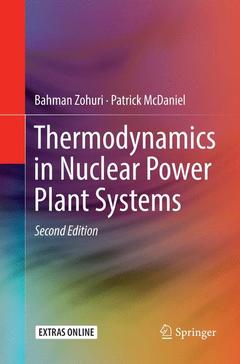Description
Thermodynamics in Nuclear Power Plant Systems (2nd Ed., Softcover reprint of the original 2nd ed. 2019)
Language: English
Subject for Thermodynamics in Nuclear Power Plant Systems:
Publication date: 12-2018
Support: Print on demand
Publication date: 09-2018
Support: Print on demand
Description
/li>Contents
/li>Biography
/li>Comment
/li>
This revised book covers the fundamentals of thermodynamics required to understand electrical power generation systems, honing in on the application of these principles to nuclear reactor power systems. This text treats the fundamentals of thermodynamics from the perspective of nuclear power systems. In addition to the Four Laws of Thermodynamics, it discusses Brayton and Rankine power cycles in detail with an emphasis on how they are implemented in nuclear systems. Chapters have been brought up-to-date due to significant new results that have become available for intercooled systems and combined cycles and include an updated steam table. The book starts with basic principles of thermodynamics as applied to power plant systems. It then describes how Nuclear Air-Brayton systems will work. It documents how they can be designed and the expected ultimate performance. It describes several types of Nuclear Air-Brayton systems that can be employed to meet different requirements andestimates component sizes and performance criteria for Small Modular Reactors (SMR) based on the Air-Brayton concept. The book provides useful insight into the engineering of nuclear power systems for students and the tabular data will be of great use to practicing engineers.
Dr. Bahman Zohuri is currently University of New Mexico, Department of Electrical and Computer Engineering, while at the Galaxy Advanced Engineering, Inc. a consulting company that he stared himself in 1991 when he left both semiconductor and defense industries after many years working as a chief scientist. After graduating from University of Illinois in field of Physics and Applied Mathematics, he joined Westinghouse Electric Corporation where he performed thermal hydraulic analysis and natural circulation for Inherent Shutdown Heat Removal System (ISHRS) in the core of a Liquid Metal Fast Breeder Reactor (LMFBR) as a secondary fully inherent shut system for secondary loop heat exchange. All these designs were used for Nuclear Safety and Reliability Engineering for Self-Actuated Shutdown System. He designed the Mercury Heat Pipe and Electromagnetic Pumps for Large Pool Concepts of LMFBR for heat rejection purpose for this reactor around 1978 where he received a patent for it. He later on was transferred to defense division of Westinghouse where he was responsible for the dynamic analysis and method of launch and handling of MX missile out of canister. The results are applied to MX launch seal performance and muzzle blast phenomena analysis (i.e. missile vibration and hydrodynamic shock formation). He also was involved in analytical calculation and computation in the study of Nonlinear Ion Wave in Rarefying Plasma. The results are applied to the propagation of "Soliton Wave" and the resulting charge collector traces, in the rarefactions characteristic of the corona of the a laser irradiated target pellet. As part of his graduate research work at Argonne National Laboratory, he performed computation and programming of multi-exchange integral in surface physics and solid state physics. He holds different patent in areas such as diffusion processes and design of diffusion furnace while he was senior process engineer working for different semiconductor indust




